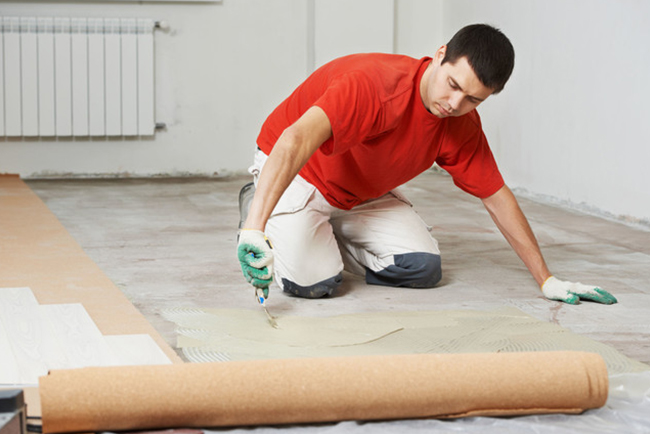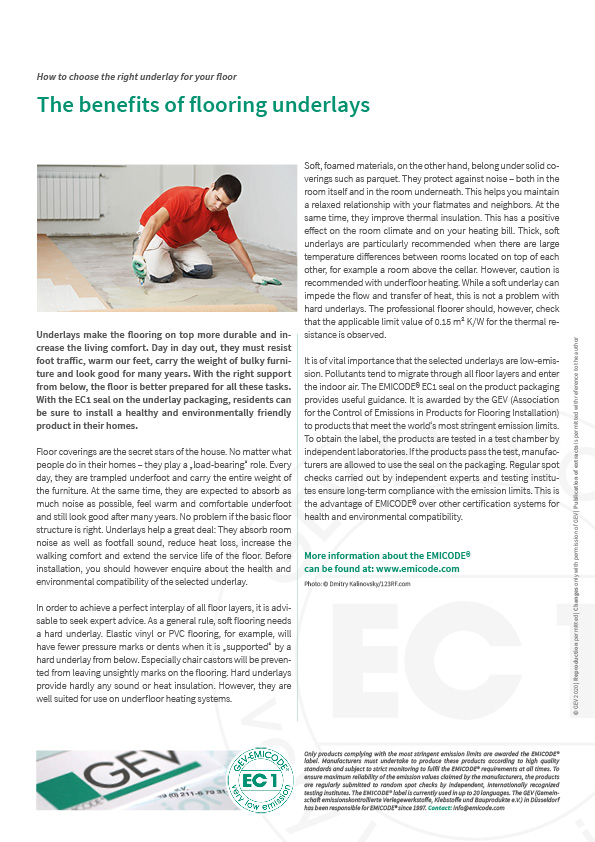The benefits of flooring underlays
How to choose the right underlay for your floor
Floor coverings are the secret stars of the house. No matter what people do in their homes – they play a “load-bearing” role. Every day, they are trampled underfoot and carry the entire weight of the furniture. At the same time, they are expected to absorb as much noise as possible, feel warm and comfortable underfoot and still look good after many years. No problem if the basic floor structure is right. Underlays help a great deal: They absorb room noise as well as footfall sound, reduce heat loss, increase the walking comfort and extend the service life of the floor. Before installation, you should however enquire about the health and environmental compatibility of the selected underlay.
In order to achieve a perfect interplay of all floor layers, it is advisable to seek expert advice. As a general rule, soft flooring needs a hard underlay. Elastic vinyl or PVC flooring, for example, will have fewer pressure marks or dents when it is “supported” by a hard underlay from below. Especially chair castors will be prevented from leaving unsightly marks on the flooring. Hard underlays provide hardly any sound or heat insulation. However, they are well suited for use on underfloor heating systems.
Soft, foamed materials, on the other hand, belong under solid coverings such as parquet. They protect against noise – both in the room itself and in the room underneath. This helps you maintain a relaxed relationship with your flatmates and neighbors. At the same time, they improve thermal insulation. This has a positive effect on the room climate and on your heating bill. Thick, soft underlays are particularly recommended when there are large temperature differences between rooms located on top of each other, for example a room above the cellar. However, caution is recommended with underfloor heating. While a soft underlay can impede the flow and transfer of heat, this is not a problem with hard underlays. The professional floorer should, however, check that the applicable limit value of 0.15 m² K/W for the thermal resistance is observed.
It is of vital importance that the selected underlays are low-emission. Pollutants tend to migrate through all floor layers and enter the indoor air. The EMICODE® EC1 seal on the product packaging provides useful guidance. It is awarded by the GEV (Association for the Control of Emissions in Products for Flooring Installation) to products that meet the world’s most stringent emission limits. To obtain the label, the products are tested in a test chamber by independent laboratories. If the products pass the test, manufacturers are allowed to use the seal on the packaging. Regular spot checks carried out by independent experts and testing institutes ensure long-term compliance with the emission limits. This is the advantage of EMICODE® over other certification systems for health and environmental compatibility.

Photo: ©Dmitry Kalinovsky/123RF.com
Underlays make the flooring on top more durable and increase the living comfort. Day in day out, they must resist foot traffic, warm our feet, carry the weight of bulky furniture and look good for many years. With the right support from below, the floor is better prepared for all these tasks. With the EC1 seal on the underlay packaging, residents can be sure to install a healthy and environmentally friendly product in their homes.

Do You Have Questions?
If you have questions about specific topics or if you would like to contact us for any other reason, feel free to contact us by phone, fax or e-mail.
Phone: +49 211 / 67931-20
Fax: +49 211 / 67931-33
info@emicode.com
Share article on Social Media:
